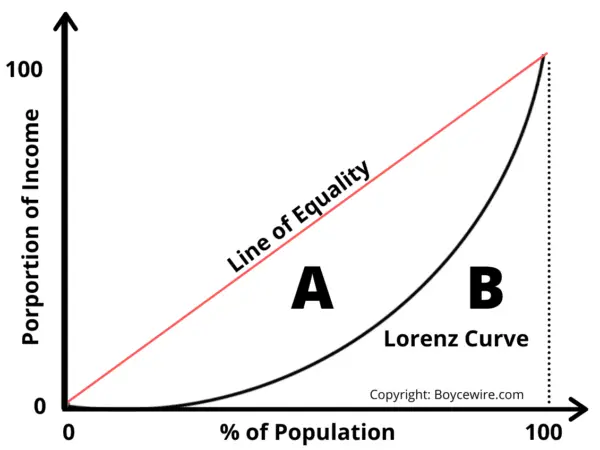J
Jeanne Stansak
dylan_black_2025
AP Microeconomics 🤑
95 resourcesSee Units
Introduction
YOU MADE IT!!!! Welcome to the final section in all of AP Micro. That's right, you've fought through utility maximization, supply and demand, perfect competition, monopolies, game theory, labor markets, externalities, and now you're at the final section!

This last unit is a quite small one, but is integral to your full understanding of how markets can fail. This section covers one of the biggest ways the free market fails: inequality. This whole course we've discussed how markets can fail by underproducing or overproducing, but we haven't yet looked at the very real reality that markets also lead to extremely unequal societies. This guide will discuss how we measure inequality by using a model called the Lorenz Curve and discuss different tax structures that help to mitigate inequality and make people pay their fair share. Unfortunately, there's no end all be all solution for inequality and it's a problem that exists in all economies. Without further ado, let's jump into it!
Types of Inequality
There are two types of economic inequality: (1) income inequality, and (2) wealth inequality. Income inequality looks at how annual earnings are distributed and wealth inequality looks at how assets are distributed. There are several sources of these two types of inequality, including abilities/human capital, social capital, inheritance, effects of discrimination, access to financial markets, mobility, and bargaining power within economic and social units.
The Lorenz Curve
We use a graph known as the Lorenz Curve to graphically represent income inequality. The Gini Coefficient is a numerical measurement of income inequality. It is a statistical measurement of income equality where perfect equality is 0 and perfect inequality is 1. The government can help with income inequality by either increasing the amount it taxes wealthier citizens or by increasing transfer payments to the poor. Transfer payments are government payments to individuals or businesses designed to meet a specific objective rather than pay for goods or resources (Ex: welfare).

The Lorenz curve shows the actual income distribution in a society. The larger the gap between perfect equality and the Lorenz curve, the greater the amount of income inequality that exists. For example, here's a Lorenz Curve for different levels of inequality:

We can use the Lorenz curve to calculate the Gini Coefficient for a society. The Gini Coefficient is the ratio of A to the total area under the equality line. Mathematically, that is to say: Gini Coefficient = A / (A + B). A higher value of the Gini Coefficient implies higher inequality, since this means the Lorenz Curve is much steeper.

Here's a map of the Gini Coefficient across the world. The world average Gini Coefficient is between 0.61 and 0.68.
Types of Taxes
There are several types of taxes that can contribute to or help with income inequality. 💸
- Progressive taxes take a larger percentage of income from high-income groups than from low-income groups. The most common example of a progressive tax is the Federal Income Tax System in the United States. This system divides people into tax brackets based on their income level, and taxes people increasing amounts as income increases. To demonstrate, someone making between $0 and $14,100 this year is taxed 10% of that income, while someone making between $14,101 and $53,700 this year is taxed 12% of that income.
- Regressive taxes take a larger percentage from low-income groups than from high-income groups. The most common example of a regressive tax is sales tax in the United States. Let's say the sales tax is 5% in a state, and Sally and Bob both spend $200 in sales taxes. Sally only makes $10,000 a year, so this $200 takes a larger percentage of her income than Bob, who makes $100,000 a year. Although this sales tax is the same for everyone, someone in a low-income group will feel the burden of this tax more than someone in a high-income group. It's important to note that a flat tax is actually regressive! This is because proportionally, lower-income groups pay a higher percentage of their income compared to high-income groups. For example, suppose everyone had to pay $100 in taxes every year. Someone making $1000 a year pays 10% income tax, whereas someone making $10000 per year only pays a 1% income tax.
- Proportional taxes takes the same percentage of income from all income groups. For example, if there was a 20% flat income tax on all income groups, each income group is equally affected by the tax. This would mean making $100 taxes you $20 and making $1000 taxes you $200.
Browse Study Guides By Unit
💸Unit 1 – Basic Economic Concepts
📈Unit 2 – Supply & Demand
🏋🏼♀️Unit 3 – Production, Cost, & the Perfect Competition Model
⛹🏼♀️Unit 4 – Imperfect Competition
💰Unit 5 – Factor Markets
🏛Unit 6 – Market Failure & the Role of Government
📝Exam Skills: FRQ/MCQ

Fiveable
Resources
© 2023 Fiveable Inc. All rights reserved.